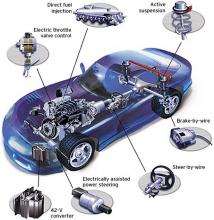
Controller Area Network – CAN is a communication network standard, allows microcontrollers and devices to communicate with each other within automobile, vehicle, ship or aircraft without a host computer. CAN protocol is message based, very much suitable for automotive application as well as industrial and medical equipment automization. It is often known as CAN-bus
CAN was started at Robert Bosch GmbH in 1983. At 1986 the CAN Protocol was released officially at the “Society of Automotive Engineers” – SAE congress in Detroit, Michigan.
The CAN Protocol
Controller Area Network is a multi master broadcasting serial bus standard to connect electronic control units.
Each node is able to either send or receive message at a time. A message contains a eight bytes ID, usually identify the message type or sender and transmitted serially onto the bus. The signal is encoded in Not Returned to Zero – NRZ line code and sensed by every node.
Each Node Contains
- Host Processor: Decide about the received command / message and also data it wants to transmit. Sensors, actuators, control devices etc are connected to the host processor.
- CAN Controller: It stores received bits serially from the bus until the whole message arrives, then the host processor fetch the message. Host processor stores the sending message within can controller and the controller transmit the message serially
- Transceiver: Adapts received signal level to protect circuit of CAN Controller. It also transmit signal onto the bus.
Bit rates upto 1Mbps for 40m network length. However, more distance can be achieved with lower bit rates.
This protocol mainly the data link layer — composed of the logical link control (LLC) sublayer and the media access control (MAC) sublayer — and some aspects of the physical layer in OSI reference model.
CAN Standards:
- ISO 11898-1: CAN Data Link Layer and Physical Signalling
- ISO 11898-2: CAN High-Speed Medium Access Unit
- ISO 11898-3: CAN Low-Speed, Fault-Tolerant, Medium-Dependent Interface
- ISO 11898-4: CAN Time-Triggered Communication
- ISO 11898-5: CAN High-Speed Medium Access Unit with Low-Power Mode
- ISO 11992-1: CAN fault-tolerant for truck/trailer communication
- ISO 11783-2: 250 kbit/s, Agricultural Standard
- SAE J1939-11: 250 kbit/s, Shielded Twisted Pair (STP)
- SAE J1939-15: 250 kbit/s, UnShielded Twisted Pair (UTP) (reduced layer)

Comments
B. Shrinivas
is it a computer network application
CAN is really necessory
Jeanine House
I hope you can help me we are looking for someone who could help us communicate with the CAN network to alter electric steering and make it easier. We fit vehicles with effortless steering and lifts. I have been searching the web and have found no one, so if you have any ideas for me i would be grateful